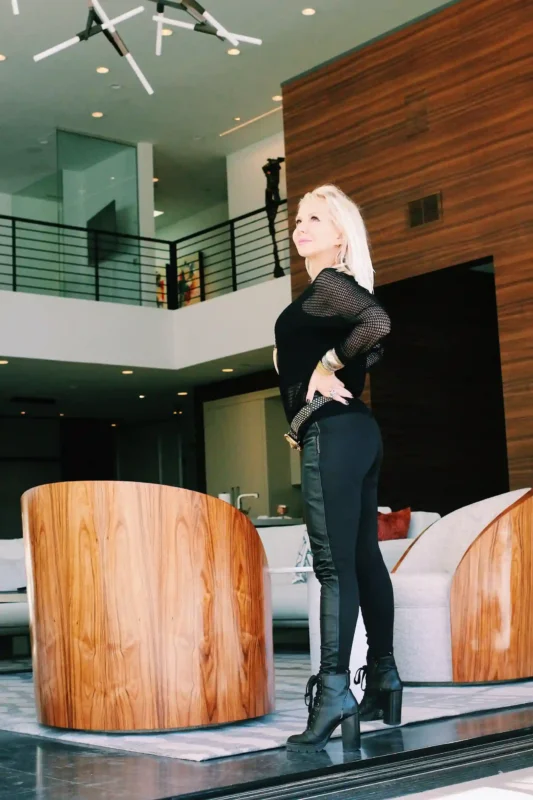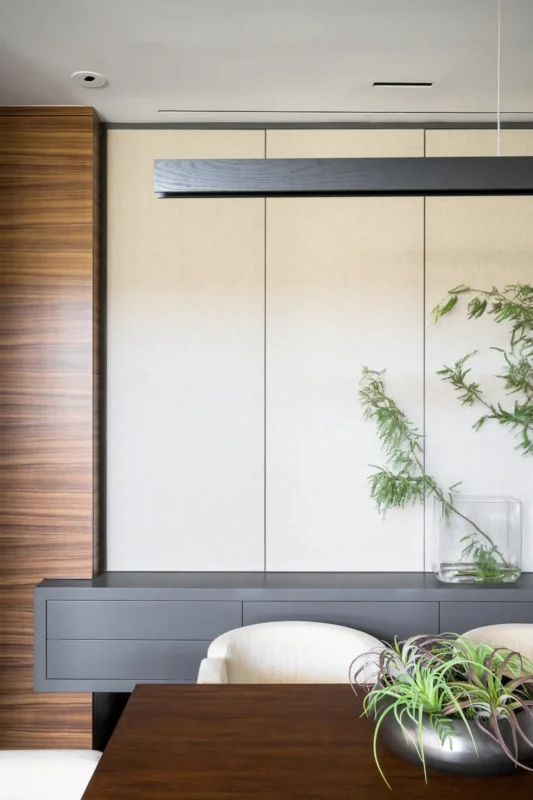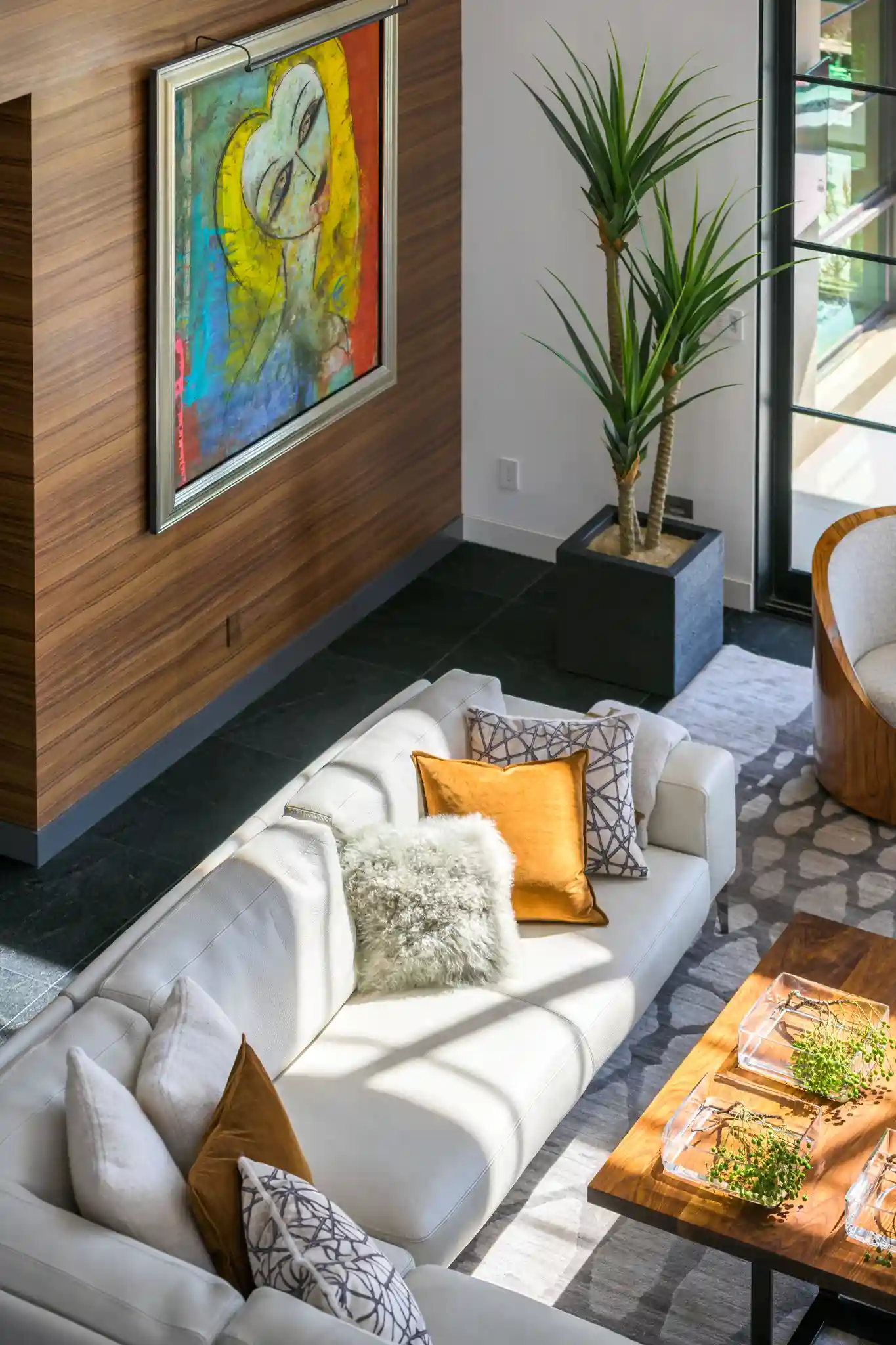The New Luxury—Built to Be Kept
When Anita Lang was young, she remembers her aunt visiting from Germany, wearing the most exquisite pair of cognac-colored leather pants. They were impeccably tailored—every stitch flawless, every detail intentional. Over the years, her aunt would wear them again and again, styled in new ways but always looking just as elegant. To Anita, those pants weren’t just fashion. They were a philosophy.
“They were the most glorious pants I’d ever seen,” she recalls. “She probably wore them for over a decade. And they still looked perfect. That stuck with me.”

That early impression helped shape Anita’s design ethos: luxury is not about excess. It’s about quality. Craftsmanship. Longevity. And, increasingly, sustainability.
In a world where trend-driven design leads to short-lived structures and disposable interiors, Anita believes in something different—a return to design that’s meant to last. “When you do it right,” she says, “you’re not building something that’s going to be torn down in 50 years. You’re creating a home that people will want to preserve for 100.”
Redefining Luxury: From Opulence to Endurance
Historically, luxury has been synonymous with extravagance—rare materials, bold statements, and grand gestures. But today’s discerning clientele—and the artisans, architects, and designers who serve them—are embracing a more thoughtful approach.
The new luxury isn’t about chasing trends. It’s about crafting spaces with soul. It’s about investing in design that’s not just beautiful today, but will remain relevant and revered for decades to come.
An example lives just minutes away: Frank Lloyd Wright’s Taliesin West in Scottsdale, Arizona. Designed in the 1930s as his winter home and studio, it’s a masterclass in sustainable architecture, long before “eco-conscious design” became a buzz-worthy phrase. Built using desert stone and sand, with passive cooling techniques and low-profile forms that blend into the Sonoran landscape, Taliesin West was never meant to be flashy. It was intended to last.
Nearly a century later, it still does. And more importantly, it’s cherished.
That’s the essence of timeless design: when something is crafted with integrity, people want to keep it.
This long-term thinking challenges the industry’s faster, cheaper mindset. It asks us to pause and consider:
– Will this home still feel meaningful in 20 years?
– Are the materials and forms rooted in something more profound than current style?
– Can this design endure the test of time, both physically and emotionally?
Luxury interior design, especially in Arizona’s evolving landscape, is now measured not just by beauty, but by intention.
Designing with Intention: The Practice of Sustainable Luxury

Sustainability in the luxury space has evolved far beyond reclaimed wood and recycled materials. Today, it’s about designing with clarity of purpose—where every choice, from architectural detailing to soft furnishings, supports both longevity and environmental responsibility.
For those working in high-end design—architects, builders, furniture makers—this means rethinking the foundation of what makes something “luxurious.” It’s no longer about excess. It’s about intention, quality, and legacy.
Material Integrity
Timeless spaces begin with timeless materials. Natural stone, enduring hardwoods, hand-forged metals—these are more than aesthetic choices. They age gracefully, wear beautifully, and reduce the need for replacement. Design teams increasingly prioritize local sourcing to minimize environmental impact and support regional craftspeople who uphold traditional methods.
In Arizona, for example, integrating desert stone, thermally modified wood, or even reclaimed saguaro rib can root a space in its natural context, creating a design that feels both grounded and elevated.
Designing for Longevity
When homes are designed well, they’re preserved, not demolished. This requires a shift from “what’s trending” to “what will still resonate in 50 years.” Flexible layouts, enduring palettes, and sculptural elements that honor form and function all contribute to a design that won’t be torn down when tastes change.
Architectural decisions—such as minimizing drywall in favor of excavated materiality or using materials that patina instead of decay—signal long-term thinking. These aren’t just stylistic gestures. They’re part of a more profound commitment to craftsmanship and permanence.
Craft Over Convenience
High-end collaborators are increasingly turning to bespoke makers and heritage techniques, not to be performative but because they result in work that lasts. A custom dining table with dovetail joinery isn’t just beautiful—it’s engineered to outlast generations. The same goes for site-specific lighting, handwoven textiles, or architectural millwork done correctly, not quickly.
“When you build with care and not just for the moment, people will preserve it. They’ll want to keep it standing.” — Anita Lang
A Healthier Kind of Luxury
Sustainable interiors aren’t just good for the planet—they’re better for the people living in them. Low-VOC paints and finishes, proper ventilation, and natural materials that don’t off-gas create healthier spaces from day one.
Many luxury homes now incorporate biophilic elements—such as daylight, indoor greenery, and even water features—to enhance well-being. These strategies align with emerging research in neuroscience, which shows that thoughtfully designed environments can reduce stress, improve sleep, and support creativity.
Legacy Over Landfill: Why Timeless Design Matters
In luxury architecture and interior design, the most critical question isn’t “What’s in style?” It’s “Will this still matter in 50 years?”
Design that endures becomes part of a home’s identity—its soul. It resists the cycle of demolition and rebuilds not out of stubbornness but out of reverence. When conceived with vision and integrity, a space earns the same respect as art or architecture with cultural significance.

Across the world, we preserve homes by Frank Lloyd Wright not because they are old, but because they were designed with philosophy, not fashion. These structures weren’t built to chase trends. They were built to hold meaning.
Rather than designing for resale or refresh, the focus is shifting to crafting spaces worthy of being kept—spaces that reflect not only personal style but cultural and environmental consciousness.
It’s a quiet rebellion against disposability.
For designers, architects, and makers, this shift opens the door to deeper collaboration. Conversations become less about what’s popular and more about what will endure. Less about status signaling, more about storytelling.
And that story often begins not with something new, but something meaningful.
A Shared Standard: The Quiet Power of Collaboration
The evolution of sustainable luxury isn’t a solo pursuit. It’s shaped by the collective decisions of those who build, design, and craft with care. Architects who orient homes to honor natural light. Fabricators who choose heirloom materials over quick solutions. Builders who value craftsmanship over convenience.
When these disciplines work in harmony, they create homes that don’t just serve their owners—they outlast them, leaving a legacy for those who follow.
In Anita Lang’s studio, there’s a recurring belief: you can feel the difference when something was made with intention. That difference is rarely loud. It doesn’t beg for attention. But it lingers in the quiet precision of a dovetail joint, the perfect alignment of stone slabs, the patina of hand-finished bronze over time, and architectural details that show intelligent design.
These are not gestures of trend, but of trust. Trust in the value of restraint. Trust in the longevity of good design. And trust in the relationships that make it possible. The most important decision a savvy developer or homeowner makes is assembling their team of talent to bring their goals to reality. The project’s caliber is directly equated to the talent, experience and creativity of those they are onboarding
For collaborators in the luxury space, aligning around these values is more than an aesthetic agreement—it’s a philosophical one. It sets a higher standard that doesn’t just respond to market demand but helps shape it.
As sustainability becomes a non-negotiable and not a niche, these kinds of partnerships are becoming the blueprint for a better kind of luxury. One that honors the earth, the craft, and the client—in that order.
Built to Be Kept
Not every home is meant to last a century. But when one is, you can tell. It’s in the way it sits on the land. The way the materials hold up, not just structurally but emotionally. The way people walk through it—even decades later—with a kind of reverence.
Designing with longevity in mind is not about resisting change. It’s about resisting the unnecessary. It’s about choosing materials, forms, and collaborators that hold up, because they were never meant to be temporary.
Luxury, at its core, is care.
Care for the people who live in the space.
Care for the makers and artisans who shape it.
Care for the landscape it inhabits—and the legacy it leaves behind.
For those who believe that good design is worth preserving, there’s a shared language. And that language is spoken fluently at IMI Design.


